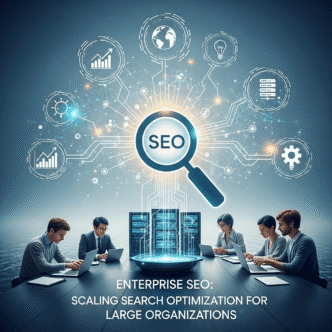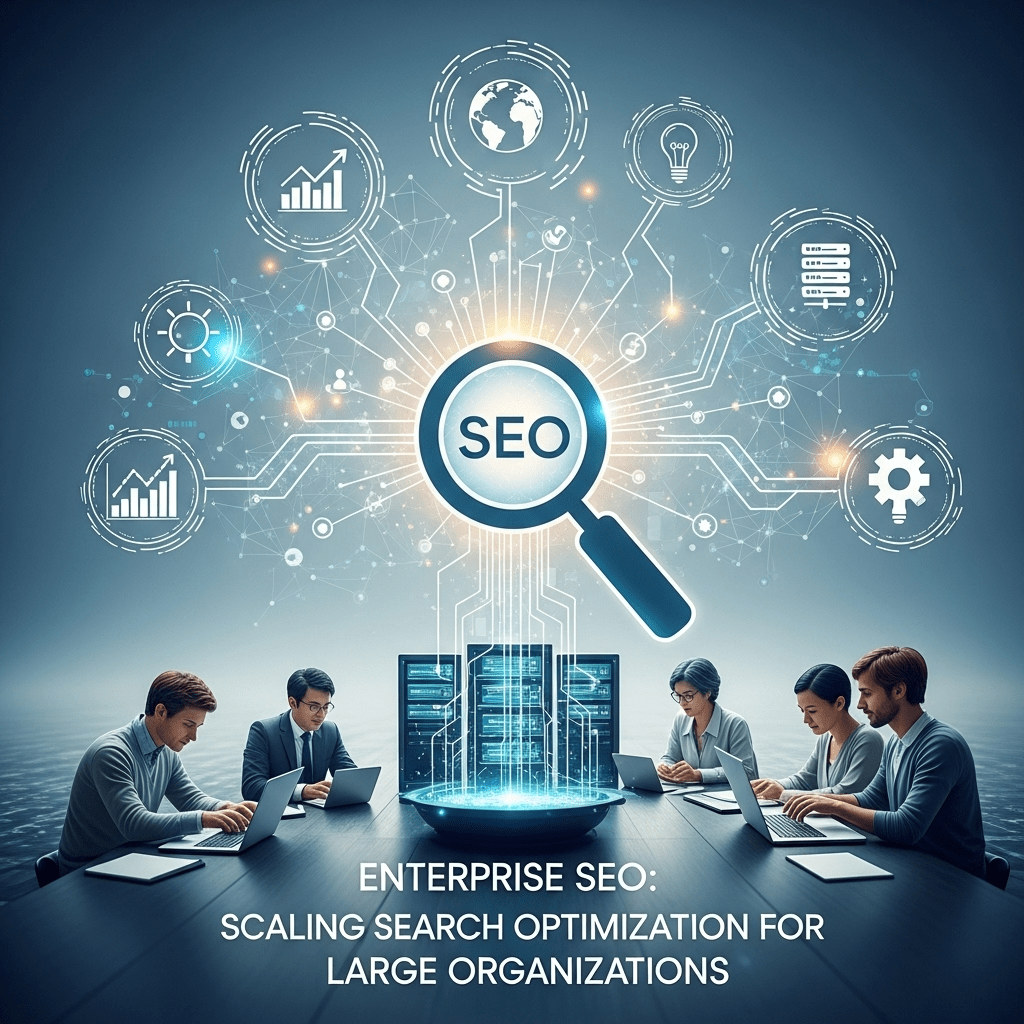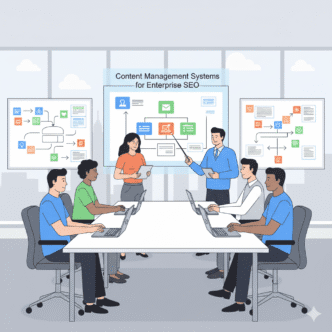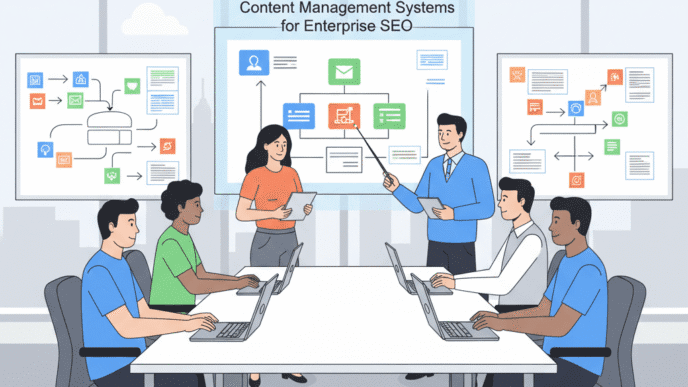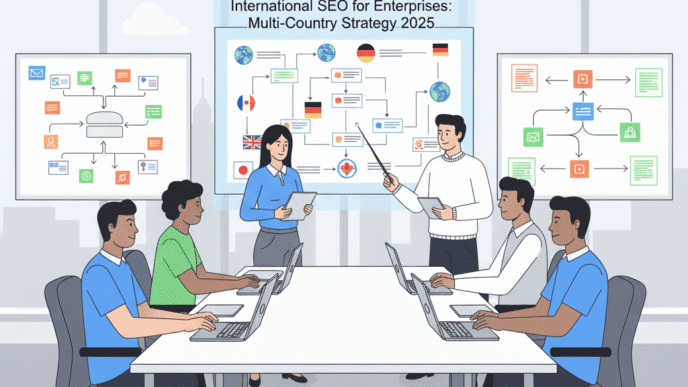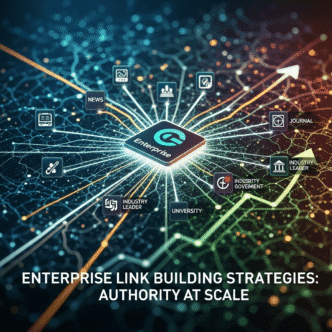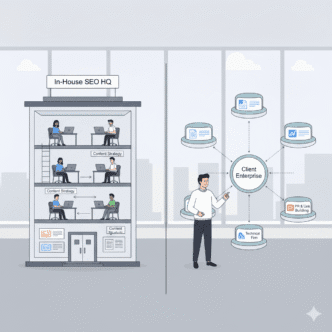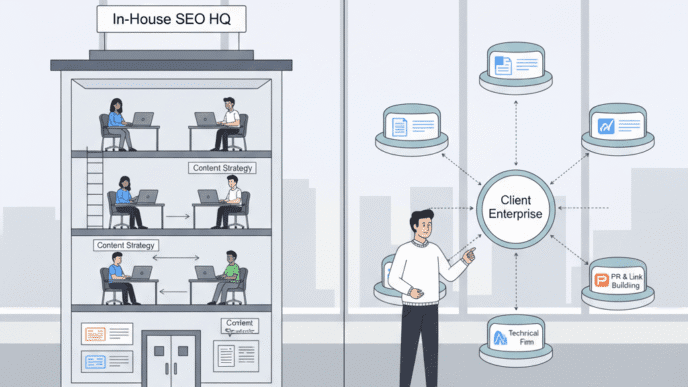Look, if you’re managing SEO for a company with 500+ pages, multiple departments fighting over the same keywords, and a tech stack that requires three meetings just to change a meta tag—welcome to enterprise SEO.
You’re not dealing with a small blog anymore. You’re orchestrating a symphony where one wrong note (like a site-wide canonical tag error) can cost you millions in organic traffic overnight.
Here’s the thing: enterprise SEO guide strategies aren’t just “regular SEO but bigger.” They’re fundamentally different beasts. And if you’re still treating your Fortune 500 website like a mom-and-pop shop, you’re leaving serious money on the table.
According to BrightEdge research, organic search drives 53% of all website traffic, making it the most significant channel for enterprise organizations. Yet most large companies are still fumbling the fundamentals.
Let me walk you through exactly how to scale search optimization for large organizations without losing your mind in the process.
Table of Contents
ToggleWhat Makes Enterprise SEO Different from Traditional SEO?
Enterprise SEO isn’t about writing a few blog posts and hoping for the best. It’s about managing thousands (sometimes millions) of pages, coordinating across multiple teams, and making data-driven decisions that impact the entire organization.
Traditional SEO? You might optimize 50 pages manually and call it a day. Enterprise SEO means building systems that automatically optimize 50,000 pages while you sleep.
The difference boils down to three things: scale, complexity, and stakeholder management. You’re not just an SEO expert anymore—you’re a project manager, a diplomat, and occasionally a therapist when developers tell you that implementing schema markup would “break the entire website.
Pro Tip: The biggest mistake enterprise SEO teams make is trying to manually optimize everything. Build systems and processes first, then scale. Your sanity will thank you.
Why Do Large Organizations Need a Dedicated Enterprise SEO Strategy?
Because generic SEO tactics break at scale. Simple as that.
When you’re managing an enterprise-level website, you’re dealing with challenges that small businesses never encounter. Multiple content management systems. International domains. E-commerce platforms with millions of product pages. Corporate policies that require six approval layers before publishing a single blog post.
Research from Conductor shows that 70-80% of users ignore paid ads and focus on organic results, making SEO investment critical for enterprise visibility. Yet many large organizations still treat it as an afterthought.
Here’s what happens without a proper enterprise search engine optimization strategy:
- Different departments create duplicate content competing against each other
- Technical debt piles up until site speed becomes a ranking nightmare
- Nobody owns SEO metrics (or everyone does, which is worse)
- Migration disasters that tank traffic by 40% overnight
Large-scale SEO management requires dedicated resources, executive buy-in, and a framework that survives leadership changes. One Fortune 500 company I know lost their entire SEO roadmap when their CMO left—because everything lived in his head instead of documented processes.
How Does Enterprise SEO Differ Across Industries?
Not all enterprises are created equal. Your enterprise SEO tactics for a SaaS company with 10,000 landing pages look completely different from an e-commerce retailer with 5 million product SKUs.
Enterprise E-commerce SEO
You’re managing product pages that change inventory daily, category pages that compete with each other, and faceted navigation that creates infinite URL variations. Your biggest enemy? Duplicate content and crawl budget waste.
E-commerce giants need to focus on programmatic SEO, automated product descriptions using structured data, and category optimization that doesn’t cannibalize your own rankings.
B2B Enterprise SEO
Longer sales cycles mean your content strategy spans awareness, consideration, and decision stages. You’re targeting decision-makers who Google things like “enterprise software comparison” at 2 AM before a board meeting.
B2B enterprise SEO strategies prioritize thought leadership content, technical whitepapers, and ROI-focused landing pages. And yes, you still need to convince your CEO that blogging isn’t “just marketing fluff.”
Healthcare & Finance (Regulated Industries)
Welcome to compliance hell. Every piece of content needs legal approval. YMYL (Your Money or Your Life) standards mean Google scrutinizes your content with a microscope.
Enterprise SEO for regulated industries requires E-E-A-T signals on steroids: author credentials, medical review boards, citations to peer-reviewed studies, and regular content audits to maintain accuracy.
What Are the Key Components of an Enterprise SEO Framework?
Building an enterprise SEO framework means creating a structure that survives team changes, platform migrations, and that one executive who thinks “SEO is dead.
Technical SEO Infrastructure
This is your foundation. Mess this up, and everything else crumbles.
Core technical elements include:
- Site architecture that scales (think faceted navigation for millions of pages)
- International SEO setup (hreflang tags that don’t make you cry)
- JavaScript rendering that doesn’t hide your content from Google
- Core Web Vitals optimization across thousands of page templates
- Log file analysis to understand how Googlebot actually crawls your site
According to Google’s own data, pages meeting Core Web Vitals thresholds are 24% less likely to experience high bounce rates. For enterprises with millions in revenue tied to organic traffic, those percentages translate to serious money.
Pro Tip: Invest in enterprise SEO tools that provide real-time monitoring. When you have 100,000 pages, you can’t manually check if your canonical tags are working. Set up automated alerts for technical disasters before they kill your rankings.
Content Operations at Scale
You can’t manually write and optimize 5,000 blog posts. You need content production systems.
This means:
- Editorial calendars that map to customer journey stages
- Content templates based on search intent analysis
- Style guides that maintain brand voice across 50 writers
- Quality control processes that catch thin content before it publishes
- Content refresh workflows for evergreen pieces losing rankings
One enterprise client I worked with had 37 different content creators across 11 departments. Without a centralized content management system and approval workflow, they were publishing contradictory information about their own products. Chaos.
Data & Analytics Infrastructure
Enterprise SEO lives or dies by data. But not just any data—actionable intelligence that executives actually understand.
You need:
- Custom dashboards showing organic revenue impact (not just rankings)
- Segment-level analysis (how’s SEO performing for different product lines?)
- Competitive intelligence tracking enterprise competitors
- Attribution modeling that proves SEO’s contribution to pipeline
- Predictive analytics for traffic forecasting and budget planning
How Do You Build an Enterprise SEO Team Structure?
Here’s the dirty secret: one person can’t do enterprise SEO. You need a team with specialized roles.
Essential Enterprise SEO Roles
SEO Director/Head of SEO: The strategist who translates technical SEO into business outcomes. This person speaks both “engineer” and “executive.”
Technical SEO Specialists: These folks troubleshoot JavaScript rendering issues, debug structured data, and explain why your server response time matters for rankings.
Content SEO Managers: They bridge the gap between keyword research and actual content creation. They’re the ones ensuring your 200-person content team understands search intent.
SEO Analysts: Data wizards who turn Google Search Console exports into actionable insights. They spot ranking drops before executives start panicking.
Enterprise SEO Consultants: External experts who’ve seen what works (and what catastrophically fails) across multiple organizations. They prevent you from repeating costly mistakes.
In-House vs Agency vs Hybrid Models
| Model | Pros | Cons | Best For |
|---|---|---|---|
| In-House Team | Deep product knowledge, faster execution, full control | Limited external perspective, harder to scale during busy periods | Mature enterprises with consistent SEO needs |
| Agency Partnership | Broad expertise, specialized tools, scalable resources | Less product intimacy, potential communication gaps | Companies needing rapid scaling or specialized skills |
| Hybrid Approach | Best of both worlds, knowledge transfer, strategic flexibility | Requires coordination, potentially higher overall cost | Most large organizations (recommended) |
Pro Tip: The hybrid model wins for most enterprises. Keep strategic planning and day-to-day optimization in-house, but bring in agency specialists for technical audits, content scaling, and areas where you lack expertise. Nobody’s good at everything.
What Enterprise SEO Tools Are Essential for Large-Scale Optimization?
You can’t manage enterprise SEO with free tools. Sorry. You need enterprise SEO platforms that handle massive data volumes without choking.
Must-Have Enterprise SEO Software
Crawling & Technical Auditing:
- Screaming Frog SEO Spider (enterprise license for unlimited crawls)
- Botify or DeepCrawl for log file analysis and massive site crawls
- Sitebulb for visual technical audits that actually make sense
Keyword & Content Research:
- Semrush or Ahrefs (enterprise plans with API access)
- Google Search Console (obviously, but most people underutilize it)
- Clearscope or MarketMuse for content optimization at scale
Rank Tracking & Monitoring:
- STAT for tracking thousands of keywords across locations
- BrightEdge or Conductor for enterprise SEO analytics and forecasting
Link Analysis & Management:
- Majestic or Ahrefs for backlink monitoring
- Pitchbox or BuzzStream for outreach at scale
Enterprise SEO Tool Comparison
| Tool Category | Budget Option | Mid-Tier | Enterprise-Grade |
|---|---|---|---|
| Site Crawling | Screaming Frog Desktop | Sitebulb | Botify, DeepCrawl |
| Rank Tracking | Semrush | STAT | BrightEdge, Conductor |
| Content Optimization | Surfer SEO | Clearscope | MarketMuse, Conductor |
| Link Building | Manual outreach | Pitchbox | BuzzStream Enterprise |
Pro Tip: Don’t buy every shiny tool. Start with crawling, rank tracking, and keyword research platforms. Add specialized tools as specific needs arise. Tool sprawl is real, and you’ll end up paying for software nobody uses.
How Do You Conduct an Enterprise SEO Audit?
An enterprise website audit isn’t a weekend project. It’s a comprehensive analysis that takes weeks and requires cross-functional coordination.
Technical SEO Audit Components
Crawl Analysis: Run full-site crawls to identify technical issues at scale. You’re looking for:
- Broken links across thousands of pages
- Redirect chains causing crawl budget waste
- Duplicate content from URL parameters or session IDs
- Missing or improper canonical tags
- XML sitemap errors (or missing sitemaps entirely)
Site Speed Assessment: Core Web Vitals matter for rankings. Audit:
- Page load time across different page templates
- Server response times under load
- Image optimization (uncompressed images kill mobile speed)
- Third-party script bloat from marketing tags
Mobile Optimization: Google’s mobile-first indexing means your mobile site IS your site. Check:
- Responsive design implementation
- Mobile usability errors in Search Console
- Touch element spacing and tap targets
- Mobile page speed separately from desktop
Content Quality Evaluation
Not all content deserves to exist. Your enterprise content audit should ruthlessly identify:
- Thin content pages providing zero value (delete or improve)
- Keyword cannibalization where multiple pages compete for the same term
- Outdated content with incorrect information
- Orphan pages with zero internal links
Pro Tip: Use a content scoring system: each page gets rated on traffic, conversions, backlinks, and relevance. Pages scoring below threshold get improved, merged, or 301 redirected. Be ruthless. Dead weight hurts your entire domain.
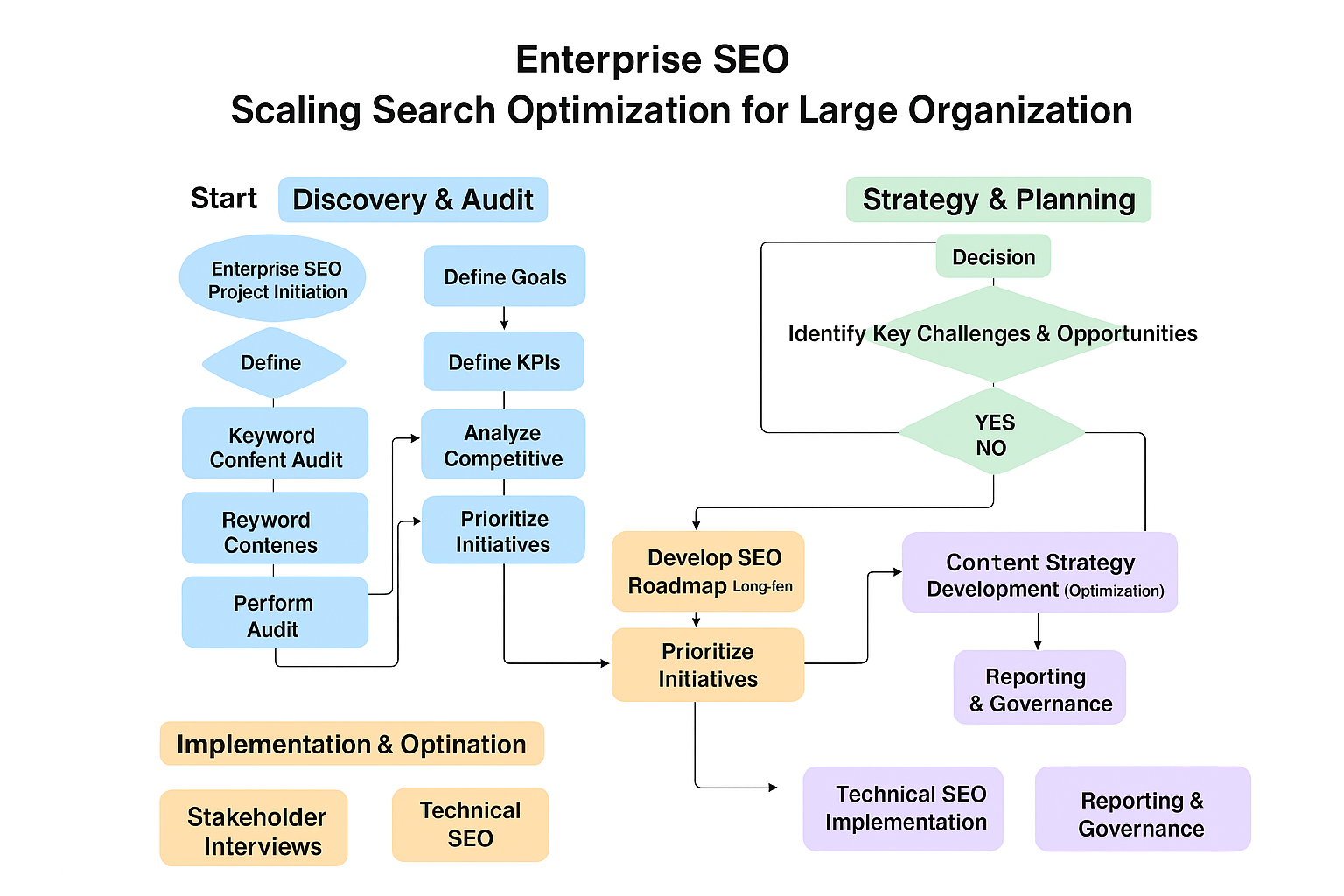
What Are the Biggest Enterprise SEO Challenges (And How to Solve Them)?
Every enterprise faces similar nightmares. Let’s talk about the big ones.
Challenge 1: Getting Executive Buy-In for SEO Investments
CFOs don’t care about rankings. They care about revenue.
Solution: Translate SEO metrics into business language. Don’t say “we increased organic traffic 40%”—say “SEO drove \$2.3M in qualified pipeline this quarter at 60% lower cost per lead than paid search.”
Build business cases showing:
- ROI calculations with conservative estimates
- Competitive threats (what happens if competitors outrank you?)
- Opportunity cost of NOT investing in SEO
Challenge 2: Coordinating Across Multiple Teams
Your SEO strategy requires cooperation from developers, content teams, legal, product managers, and IT. Good luck getting everyone on the same page.
Solution: Create a SEO governance framework with clear ownership:
- Weekly SEO standups with key stakeholders
- Documented escalation paths for urgent issues
- Shared KPIs that align teams toward common goals
- Training programs so everyone understands SEO basics
Challenge 3: Managing Technical Debt and Legacy Systems
That website platform from 2012 wasn’t built for modern SEO. But migrating would cost millions.
Solution: Prioritize fixes by impact. Create a technical debt roadmap:
- Critical issues blocking Google from crawling/indexing (fix immediately)
- High-impact optimizations (structured data, Core Web Vitals)
- Nice-to-have improvements (save for next platform upgrade)
Sometimes you can’t fix the legacy system—so you build workarounds. URL rewrites, edge-side includes, or separate content hubs on modern platforms.
Challenge 4: Scaling Content Production Without Sacrificing Quality
You need 500 SEO-optimized pages. You have 3 writers. Math doesn’t work.
Solution: Build content production systems:
- Content templates based on top-performing pages
- Subject matter expert interviews (your engineers/specialists create raw content, writers optimize)
- AI-assisted drafting for data-driven sections (then human editors add expertise)
- Quality rubrics so reviewers can quickly assess content
How Do You Implement International Enterprise SEO?
Going global means dealing with multilingual SEO, currency conversions, and cultural nuances that automatic translation misses.
International Site Structure Options
ccTLDs (country-code top-level domains): example.fr, example.de
- Strongest geo-targeting signals
- Requires separate domain management
- Best for: Enterprises with dedicated country teams
Subdirectories: example.com/fr/, example.com/de/
- Easier to manage, domain authority consolidates
- Requires proper hreflang implementation
- Best for: Most enterprises (recommended)
Subdomains: fr.example.com, de.example.com
- Treated as separate sites by Google
- More complex management
- Best for: Sites with very different content per region
Hreflang Implementation for Large Sites
Hreflang tags tell Google which language/region version to show users. Mess this up, and French users see your English content (and bounce immediately).
For enterprises with hundreds of international pages, you need:
- Automated hreflang generation in your CMS
- Bidirectional tags (if EN points to FR, FR must point back to EN)
- Self-referential tags on every page
- Regular validation because hreflang breaks constantly
Pro Tip: Use Google Search Console’s International Targeting report to catch hreflang errors. Common mistakes: wrong language codes (using “en” instead of “en-us”), missing return tags, and pointing to non-canonical URLs.
What Role Does AI and Automation Play in Enterprise SEO?
AI isn’t replacing SEO professionals—it’s making us exponentially more efficient at handling enterprise-scale SEO tasks.
AI-Powered Enterprise SEO Strategies
According to a 2024 Gartner report, organizations using AI for SEO see 40% faster content production and 25% improvement in ranking performance. The gap between AI-adopters and traditionalists is widening fast.
Automation Opportunities for Large Organizations
Content Optimization: AI tools analyze top-ranking pages and suggest keyword additions, content structure, and reading level adjustments. One enterprise client used AI-assisted optimization to refresh 3,000 product pages in 3 months (would’ve taken 2 years manually).
Technical Monitoring: Automated alerts when:
- Core Web Vitals drop below thresholds
- Pages return 404 or 500 errors
- Canonical tags change unexpectedly
- Structured data validation fails
Predictive Analytics: Machine learning models forecast:
- Traffic impact of proposed site changes
- Seasonal ranking fluctuations
- Competitive threats before they materialize
Programmatic SEO: Generate thousands of location-specific or product-specific pages using templates and databases. Think Zillow’s millions of property pages—each optimized for “[neighborhood name] homes for sale.”
Generative AI for Search Optimization
Google’s Search Generative Experience (SGE) is changing how users interact with search. Enterprise sites need to optimize for AI overviews and featured snippets that appear above traditional results.
AI-driven SEO tactics include:
- Structuring content to answer specific questions AI models pull
- Using schema markup that machine learning algorithms easily parse
- Creating comprehensive, authoritative content that becomes the source AI cites
- Monitoring zero-click search trends and adjusting strategy accordingly
What NOT to Automate
Don’t let AI write your cornerstone content. Don’t automate link outreach to the point where you’re sending spammy template emails. And definitely don’t auto-approve content changes without human review.
Pro Tip: Use AI as your first draft, not your final product. Let it handle repetitive tasks (meta descriptions for 10,000 pages) while humans focus on strategy and high-stakes content.
How Do You Measure Enterprise SEO Success?
Forget vanity metrics. Enterprise SEO measurement focuses on business impact.
Key Performance Indicators for Large Organizations
Revenue-Focused Metrics:
- Organic revenue (actual dollars from SEO traffic)
- Assisted conversions (SEO’s role in multi-touch attribution)
- Customer acquisition cost from organic vs paid channels
- Lifetime value of customers acquired through organic search
Traffic & Visibility Metrics:
- Organic sessions segmented by product/category
- Keyword rankings for high-commercial-intent terms
- Share of voice vs competitors in your industry
- Branded vs non-branded traffic ratios
Technical Health Indicators:
- Core Web Vitals pass rates across page templates
- Mobile usability errors (Google Search Console)
- Index coverage (% of important pages indexed)
- Crawl budget efficiency (pages crawled vs pages published)
Building Executive Dashboards
Your CEO doesn’t care about “keyword difficulty scores.” Create dashboards showing:
- SEO Revenue Impact: “Organic search drove \$X.XM revenue this quarter”
- Competitive Position: “We own X% more top rankings than Competitor A”
- Growth Trajectory: “On pace to reach $XXM organic revenue by year-end”
- Efficiency Metrics: “SEO delivers leads at 70% lower cost than paid channels”
What’s the Future of Enterprise SEO in 2025 and Beyond?
The enterprise SEO landscape is shifting faster than ever. Here’s what’s coming.
AI-Generated Search Experiences
Google’s Search Generative Experience (SGE) means your content might get summarized in AI overviews instead of clicked. Zero-click searches are expanding—already accounting for over 25% of all Google searches according to recent SparkToro data.
Enterprise response: Optimize for being the source AI cites. Focus on E-E-A-T signals (Experience, Expertise, Authoritativeness, Trustworthiness) that LLMs recognize as credible sources.
Programmatic SEO at Massive Scale
We’re talking millions of unique, valuable pages generated from structured data. Not thin doorway pages—genuinely useful content that serves user intent.
Enterprise SEO trends show companies using:
- AI to personalize content at scale
- Dynamic page generation based on user behavior
- Real-time content updates from databases
- Machine learning-powered content recommendations
Privacy-First Tracking and Attribution
Third-party cookies are dying. Enterprise SEO measurement needs to adapt with:
- First-party data strategies
- Server-side tracking implementations
- Modeling and machine learning for attribution gaps
- Consent-based analytics that respect privacy regulations
Pro Tip: Start investing in first-party data infrastructure now. Enterprises that can still track customer journeys after cookie deprecation will have massive competitive advantages.
Voice and Visual Search Optimization
Voice searches now account for approximately 20% of mobile queries, according to recent industry reports. Visual search technology is advancing rapidly, especially for e-commerce.
Enterprises need strategies for:
- Conversational keyword targeting for voice assistants
- Image SEO and visual product discovery
- Featured snippet optimization for voice results
- Local SEO integration with voice search queries
Common Enterprise SEO Mistakes and Pitfalls to Avoid
Let’s talk about the career-ending mistakes I’ve seen enterprises make repeatedly.
Mistake #1: Platform Migration Without Proper SEO Planning
I’ve watched companies lose 60-80% of organic traffic overnight because they didn’t involve SEO until after their new website launched.
How to avoid: Create a comprehensive migration checklist including:
- Complete URL mapping with 301 redirects
- Content parity analysis
- Pre-migration crawl baseline
- Staged rollout with monitoring
- Rollback plan when things go wrong
Never, ever do a “big bang” migration. Stage it by section and monitor carefully.
Mistake #2: Ignoring International SEO Until It’s Too Late
Launching international sites without proper hreflang implementation creates duplicate content nightmares. I’ve seen enterprises where the French site cannibalizes the English site’s rankings.
How to avoid:
- Plan international structure from day one
- Implement hreflang correctly (not “good enough”)
- Create region-specific content, don’t just translate
- Use native speakers for content review
Mistake #3: Over-Relying on Paid Search and Neglecting Organic
When companies slash SEO budgets during downturns but maintain paid search, they’re literally choosing the more expensive customer acquisition channel.
According to a BrightEdge study, organic search delivers 20x more traffic opportunities than paid search, yet many enterprises still prioritize PPC spending.
How to avoid: Calculate true customer acquisition cost across all channels. You’ll find organic search often delivers 3-5x ROI compared to paid channels.
Mistake #4: Creating Silos Between SEO and Other Marketing Teams
When your SEO team doesn’t talk to content, product, or developers, you get:
- Content that doesn’t match search intent
- Product launches with zero SEO consideration
- Technical changes that destroy rankings
How to avoid: Embed SEO stakeholders in all relevant projects. Create cross-functional workflows where SEO reviews happen before launch, not after.
Mistake #5: Focusing on Rankings Instead of Revenue
Ranking #1 for a keyword with zero commercial intent is worthless. I’ve seen teams celebrate top rankings while conversions plummet.
How to avoid: Map keywords to business value. Prioritize high-intent, high-conversion terms over vanity metrics. Track revenue per keyword cluster, not just rankings.
Mistake #6: Treating Technical SEO as One-Time Work
Your technical foundation needs constant maintenance. Enterprises that “fix technical SEO once” watch it degrade over time as developers make changes.
How to avoid:
- Implement continuous monitoring and alerting
- Require SEO review for all code deployments
- Run weekly technical audits on critical page templates
- Create developer guidelines that prevent SEO disasters
Mistake #7: Using Black-Hat or Gray-Hat Tactics at Enterprise Scale
Private blog networks, link schemes, and content farms might work short-term for small sites. At enterprise scale, they’re ticking time bombs.
One manual penalty on a Fortune 500 domain can cost millions in lost revenue and years of recovery work.
How to avoid: Build white-hat strategies that scale safely. Focus on earning links through genuine value, not manipulating algorithms. Google’s Search Essentials should be your bible.
Mistake #8: Launching AI-Generated Content Without Human Oversight
Flooding your site with 10,000 AI-written pages might seem efficient. Until Google catches on and decimates your rankings.
How to avoid:
- Use AI for drafts and data-driven sections
- Always add human expertise and editing
- Ensure content provides genuine value users can’t find elsewhere
- Follow Google’s AI content guidelines
Mistake #9: Ignoring Core Web Vitals and Page Experience
“We’ll optimize performance later” becomes never. Meanwhile, your slow site is losing rankings to faster competitors.
How to avoid: Make performance a non-negotiable requirement for all pages. Build it into your definition of “done” for any development work.
Mistake #10: Not Documenting Processes and Knowledge
When your SEO genius leaves, their knowledge leaves with them. I’ve seen entire programs collapse because everything lived in one person’s head.
How to avoid: Create comprehensive documentation for:
- SEO strategies and roadmaps
- Technical configurations and why they exist
- Process workflows and approval chains
- Historical decisions and their outcomes
Treat documentation like code—version controlled, regularly updated, and accessible to the team.
How Much Does Enterprise SEO Cost?
Let’s talk numbers. Enterprise SEO pricing varies wildly, but here are realistic ranges:
In-House Team (Annual Cost):
- SEO Director: $150K-$250K
- Technical SEO Specialists (2-3): $90K-$140K each
- Content SEO Managers (2-3): $80K-$120K each
- SEO Analysts (1-2): $70K-$100K each
- Total: $500K-$1.2M+ annually
Agency Retainer:
- Small enterprise (10K-50K pages): $15K-$40K/month
- Mid-size enterprise (50K-500K pages): $40K-$100K/month
- Large enterprise (500K+ pages): $100K-$300K+/month
Enterprise SEO Tools:
- Basic stack: $3K-$8K/month
- Comprehensive platform: $10K-$50K/month
- Custom enterprise solutions: $50K-$200K+/month
Pro Tip: Budget 15-20% of your total digital marketing spend on SEO for mature enterprises. If you’re just starting, allocate more in year one for foundational work and technical cleanup.
Real-World Enterprise SEO Case Studies
Theory’s great, but let’s see actual results.
Case Study 1: Global SaaS Platform (Confidential Client)
Challenge: 15 country sites, 40,000 pages, hreflang disaster causing 60% traffic loss post-migration.
Solution:
- Complete hreflang audit and restructure
- Implemented automated hreflang generation in CMS
- Consolidated duplicate international content
- Built region-specific content strategies
Results:
- 220% organic traffic recovery over 8 months
- 43% increase in international conversions
- $4.2M additional organic revenue annually
Case Study 2: E-Commerce Retailer (10M+ SKUs)
Challenge: Massive duplicate content from faceted navigation, 3-second page load times, crawl budget waste.
Solution:
- Implemented strategic robots.txt and parameter handling
- Optimized category page templates for Core Web Vitals
- Created programmatic product description templates
- Built automated low-stock product canonicalization
Results:
- 67% improvement in Core Web Vitals scores
- 190% increase in category page rankings
- $12M additional organic revenue in first year
Case Study 3: B2B Enterprise Software Company
Challenge: 2,000-page website with no clear content strategy, minimal keyword targeting, and poor technical foundation.
Solution:
- Comprehensive keyword research mapping to buyer journey stages
- Content hub creation around core product themes
- Technical SEO overhaul including structured data implementation
- Link building campaign targeting authoritative industry publications
Results:
- 340% increase in qualified organic leads over 18 months
- 28% reduction in customer acquisition cost
- Secured 15 featured snippets for high-value keywords
- $8M pipeline contribution attributed to organic search
Frequently Asked Questions About Enterprise SEO
How long does it take to see results from enterprise SEO?
Honestly? 4-6 months minimum for initial traction, 12-18 months for substantial results. Enterprise SEO is a marathon, not a sprint.
Quick wins like fixing critical technical issues might show results in 4-8 weeks. But building authority, creating comprehensive content, and establishing domain trust takes time. Anyone promising “first page rankings in 30 days” for enterprise sites is selling snake oil.
What’s the difference between enterprise SEO and regular SEO?
Scale, complexity, and stakeholder management. Regular SEO might involve optimizing 100 pages manually. Enterprise SEO means building systems that automatically optimize 100,000 pages.
You’re also dealing with international sites, multiple brands, complex technical infrastructures, and coordinating across dozens of teams who’ve never heard of canonical tags.
Do we need a full-time SEO team or can we outsource everything?
Most successful enterprises use a hybrid model: core strategic roles in-house, specialized work outsourced. Keep your SEO Director, lead technical specialist, and analytics expert internal. Outsource content production at scale, link building campaigns, and specialized audits.
Full outsourcing creates dependency and knowledge gaps. Full in-house is expensive and limits expertise diversity.
How do we handle SEO during a website migration or redesign?
Treat it like open-heart surgery—one mistake and everything flatlines. Create a detailed migration plan including:
- Complete URL inventory and mapping
- 301 redirect strategy tested thoroughly
- Content parity analysis ensuring nothing valuable gets lost
- Staged rollout (never go “big bang”)
- Continuous monitoring with rollback plans
Involve SEO from day one of planning, not two weeks before launch.
What’s the ROI of enterprise SEO?
Done correctly, enterprise SEO typically delivers 5:1 to 10:1 ROI within 18-24 months. I’ve seen companies generating $20M+ annually from organic search with $2M in total SEO investment.
The key metric: compare your customer acquisition cost from SEO versus paid channels. Organic is almost always 50-70% cheaper once you’re past the initial investment phase.
How do we optimize for AI search and ChatGPT?
Focus on becoming the authoritative source that AI models cite. This means:
- Creating comprehensive, well-structured content
- Implementing thorough schema markup
- Building strong E-E-A-T signals (expertise, authoritativeness, trust)
- Answering questions directly and concisely
- Using natural language that matches conversational queries
AI search pulls from the best sources. Be that source.
Should we worry about Google algorithm updates?
Major updates? Yes, monitor them. But if you’re following white-hat strategies and focusing on genuine user value, most updates won’t devastate you.
The enterprises that get hammered are usually cutting corners—thin content, manipulative link building, or ignoring Core Web Vitals. Build a solid foundation and updates become minor adjustments, not existential threats.
How do we prove SEO value to executives who only care about paid ads?
Show them the cost per acquisition math. If paid search delivers leads at $500 each and organic delivers them at $150 each, which would a rational CFO choose?
Build dashboards showing:
- Organic revenue contribution
- Customer lifetime value by channel
- What would happen if you lost those rankings (competitive scenario modeling)
- Cost to replace that traffic with paid ads
Make it about business outcomes, not search rankings.
What’s the biggest enterprise SEO trend for 2025?
AI-powered programmatic SEO and optimization for generative search experiences. Companies are using AI to create millions of unique, valuable pages while optimizing for how AI models surface information.
Also watch privacy-first analytics as third-party cookies disappear and voice search optimization as conversational queries dominate mobile.
Final Thoughts: Your Enterprise SEO Success Roadmap
Here’s the brutal truth about enterprise SEO: most large organizations are still terrible at it.
They’re throwing money at paid ads while their organic traffic potential sits untapped. They’re treating SEO as a “nice to have” instead of the revenue-generating machine it can be. They’re making the same mistakes I’ve watched cost companies millions in lost opportunity.
But that’s actually good news for you. Because if you implement even half of what we’ve covered here, you’ll leapfrog competitors still doing SEO like it’s 2015.
Your 12-Month Enterprise SEO Roadmap
Months 1-3: Foundation
- Complete comprehensive technical audit
- Establish baseline metrics and goals
- Build cross-functional buy-in and governance
- Deploy essential tools and monitoring
- Document current state and create strategy roadmap
Months 4-6: Quick Wins
- Fix critical technical issues (site speed, mobile, indexing)
- Optimize high-traffic, high-value pages
- Launch content production systems
- Implement comprehensive structured data
- Build automated monitoring and alerting
Months 7-12: Scale
- Expand content operations with AI assistance
- Launch international SEO initiatives
- Develop programmatic SEO for scale
- Build predictive analytics and forecasting
- Create executive dashboards focused on revenue
Year 2+: Optimization
- Continuous improvement cycles based on data
- Competitive displacement strategies
- Emerging opportunity capture (voice, visual, AI search)
- Team expansion and specialization
- Innovation labs for testing new tactics
The Bottom Line
According to a study by Search Engine Journal, companies that invest in enterprise SEO see an average 14.6% close rate for leads, compared to 1.7% for outbound marketing. That’s not a typo—enterprise SEO delivers leads eight times more likely to convert.
The question isn’t whether you can afford to invest in enterprise SEO. It’s whether you can afford not to while your competitors are building organic traffic moats that become increasingly difficult to compete against.
Enterprise SEO isn’t about gaming algorithms or quick wins. It’s about building sustainable competitive advantages through technical excellence, authoritative content, and systems that scale.
The enterprises winning at SEO in 2025 aren’t the ones with the biggest budgets—they’re the ones with the best systems, clearest strategies, and commitment to treating SEO as a core business function rather than a marketing afterthought.
Your competitors are already implementing these strategies. The gap widens every day you wait.
Now stop reading and start building. Your organic traffic potential won’t realize itself.
🚀 Enterprise SEO Analytics Dashboard
Interactive Data & Statistics for Large-Scale Organizations
💡 Key Insight
According to BrightEdge research, organic search drives 53% of all website traffic for enterprises, making it the single most significant channel. Organizations investing in comprehensive enterprise SEO strategies see 20x more traffic opportunities compared to paid search alone.
🤖 AI-Powered SEO Statistics
- 40% faster content production with AI assistance (Gartner, 2024)
- 25% improvement in ranking performance for AI-adopters
- 60% reduction in manual optimization time
- 3x increase in programmatic page generation capability
| Model | Annual Cost | Response Time | Expertise Level | Best For |
|---|---|---|---|---|
| In-House Team | $500K - $1.2M | ⚡ Fastest | 🌟🌟🌟🌟 | Mature enterprises |
| Agency Partnership | $180K - $3.6M | ⚡⚡ Fast | 🌟🌟🌟🌟🌟 | Rapid scaling needs |
| Hybrid Model | $300K - $1.8M | ⚡⚡ Fast | 🌟🌟🌟🌟🌟 | Most enterprises (Recommended) |
| Category | Budget Option | Mid-Tier | Enterprise-Grade |
|---|---|---|---|
| Site Crawling | Screaming Frog Desktop | Sitebulb | Botify, DeepCrawl |
| Rank Tracking | Semrush Basic | STAT | BrightEdge, Conductor |
| Content Optimization | Surfer SEO | Clearscope | MarketMuse, Conductor |
| Link Building | Manual Outreach | Pitchbox | BuzzStream Enterprise |
💰 Cost Efficiency Winner: Organic SEO
Enterprise SEO delivers leads at 60-70% lower cost compared to paid channels once foundational work is complete. Initial investment pays off within 12-18 months for most organizations.
ROI = (Organic Revenue - SEO Investment) / SEO Investment × 100
Example: Enterprise invests $800K annually, generates $4.8M in organic revenue
ROI = ($4.8M - $800K) / $800K × 100 = 500% ROI (5:1 ratio)
⚡ Interactive ROI Calculator
Enter your data to calculate potential ROI:
Net Profit:
| Channel | Close Rate | Avg. Deal Size | Sales Cycle | Customer LTV |
|---|---|---|---|---|
| Organic SEO | 14.6% | $85,000 | 45 days | $420,000 |
| Paid Search | 2.8% | $52,000 | 60 days | $280,000 |
| Social Media | 2.1% | $38,000 | 75 days | $195,000 |
| Outbound Marketing | 1.7% | $45,000 | 90 days | $230,000 |
Data source: Search Engine Journal, HubSpot Enterprise Marketing Research 2024
Complete technical audit, establish baseline metrics, build cross-functional buy-in, deploy essential tools
Priority: HighFix critical technical issues, optimize high-traffic pages, launch content production systems, implement structured data
Expected Impact: 40-60% traffic increaseExpand content operations with AI, launch international SEO, develop programmatic SEO, build predictive analytics
Investment Peak: $600K-$800KContinuous improvement cycles, competitive displacement, emerging opportunities (voice, visual, AI search)
ROI Achievement: 5:1 ratio🚀 Action Steps to Get Started
- Week 1-2: Conduct stakeholder interviews and define KPIs
- Week 3-4: Run comprehensive technical audit using enterprise tools
- Week 5-8: Develop 12-month roadmap with budget allocation
- Week 9-12: Build team structure (hire or partner with agency)
- Month 4+: Execute quick wins while building long-term systems
🔍 Powered by SEOProJournal.com
Your Trusted Source for Enterprise SEO Intelligence | © 2025

